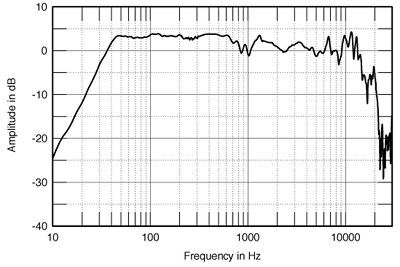| Columns Retired Columns & Blogs |
MBL 111B loudspeaker Measurements
Sidebar 3: Measurements
Other than impedance, for which I used an Audio Precision System One, all acoustic measurements were made with the DRA Labs MLSSA system and a calibrated B&K 4006 microphone. To minimize reflections from the test setup, the measuring microphone is flush-mounted inside the end of a long tube. Reflections of the speaker sound from the mike stand and its hardware will be sufficiently delayed not to affect the measurement.
Confirming what I'd experienced in my listening room, the 111B was not very sensitive. My estimate for the B-weighted figure was 80.7dB(B)/2.83V/m, which is within experimental error of the 81dB specification. MBL also specifies the 111B as a "4 ohm speaker," but my measurement of its impedance magnitude and phase (fig.1) suggests it is closer to a 6 ohm design. Other than a minimum value of 4 ohms at 11kHz and dips to below 5 ohms in the upper bass, the MBL's impedance remains above 6 ohms for much of the audioband. What might give problems with less beefy amplifiers is the electrical phase angle, which reaches quite large capacitive values in the low bass. While the impedance magnitude is high enough at 9.1 ohms to ameliorate the maximum phase angle of -52 degrees at 33.5Hz, it drops to less than 5 ohms a little higher in frequency, while the phase angle remains above 40 degrees.

Fig.1 MBL 111B, electrical impedance (solid) and phase (dashed). (2 ohms/vertical div.)
The impedance plot is free from the little wrinkles and discontinuities that would indicate the presence of cabinet-wall resonances, and the coupled-cavity woofer enclosure turned out to be optimally braced and damped, with no vibrational modes present within its passband. The midrange enclosure did have some modes at 300Hz and 500Hz, but these were well down in level (fig.2), which, in combination with the small radiating areas of this enclosure's panels, means that they should not add coloration.

Fig.2 MBL 111B, cumulative spectral-decay plot calculated from the output of an accelerometer fastened to the cabinet's rear panel level with the midrange/woofer transition. (MLS driving voltage to speaker, 7.55V; measurement bandwidth, 2kHz.)
Fig.3 shows the responses, from left to right, of the ports in the woofer cabinet, the cone midrange units, and the upper-midrange Radialstrahler unit. Note that the woofer cabinet's high-pass roll-in is at 12dB/octave rather than the 24dB/octave usual with a ported design, due to the fact that the drive-unit's anti-phase output doesn't make it to the outside world. Coupled-cavity speakers can suffer from hoots and whistles above their nominal passband, but the output of MBL's woofer cabinet above its measured 100Hz crossover point rolls off cleanly with no peaks apparent. The upper-frequency rolloff looks more like 18dB/octave than the specified 24dB/octave, however. The side-mounted cone midrange units roll in at the correct 24dB/octave rate, crossing over in turn to the Radialstrahler unit at around 550Hz.

Fig.3 MBL 111B, nearfield responses of (from left to right): woofer ports, lower-midrange unit, upper-midrange unit.
How these individual outputs add on the specified listening axis is shown in fig.4, which splices the complex sum of the nearfield responses below 300Hz to the output on the listening axis, averaged across a 30 degrees horizontal window. The low frequencies are textbook-flat, which, with the nearfield measurement, might actually suggest a slightly shelved-down response—an anechoically flat speaker will appear to have a 3dB hump in the lows when measured in the nearfield. This is ideal for matching to typically sized rooms.

Fig.4 MBL 111B, anechoic response on listening axis at 50" with grille on, averaged across 30 degrees horizontal window and corrected for microphone response, with the complex sum of the nearfield midrange and port responses plotted below 300Hz.
The bass rolls off to -6dB at a low 30Hz. Higher in frequency, most of the region covered by the Radialstrahler units is shelved down by a couple of dB, which might have contributed to the laid-back low- and middle-treble registers I noted in my auditioning. There is some peakiness around 10kHz, which might have contributed to the slight emphasis of sibilance I occasionally noted, above which the tweeter's output falls off quite rapidly. The grille was left on for this measurement, by the way, which was significant, as you'll see.
The grille was also left on for the next measurement, a plot of the 111B's lateral dispersion (fig.5). I usually examine a speaker's behavior only in the forward solid angle, but as the MBL is an omnidirectional design, I plotted its dispersion over the full 360 degrees. It can be seen from this graph that the top two audio octaves are indeed fully represented to the speaker's sides and back—very different behavior from a conventional forward-firing tweeter-midrange combination. Note, however, that the radiation pattern is quite ragged in this region, which is due, I discovered, to serious reflections of the sound from the perforated metal grille. There is also some falloff to the sides between 300Hz and 1kHz, this presumably due to the fact that this corresponds to the maximum spacing between the side-mounted lower-midrange units.

Fig.5 MBL 111B, lateral response family at 50" with grille on, normalized to response on listening axis, from back to front: differences in response 180 degrees-5 degrees off-axis, reference response, differences in response 5 degrees-180 degrees off-axis.
- Log in or register to post comments




































